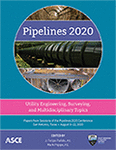Pipelines 2020
Development of a Consequence of Failure Model and Risk Matrix for Water Pipelines Infrastructure Systems
Publication: Pipelines 2020
ABSTRACT
Water utilities are finding it more cost-effective to practice a risk-based and data-driven proactive renewal planning to avoid extra costs from reactive repair and replacement. Risk is a function of the likelihood of failure (LoF) and the consequence of failure (CoF). This study conducted a comprehensive review of past studies on CoF and risk matrix, from both literature and practice to develop a better methodology for assessing CoF and developing risk matrix. The proposed CoF model enhances the triple-bottom line parameters and includes operational intelligence and renewal complexity in assessing CoF. Therefore, the model can overcome the limitation in the previous studies that considered only direct costs of a water pipeline failure. The proposed model develops a fuzzy inference system (FIS) to model system parameter interdependencies using IF-ELSE rules and incorporate heuristic knowledge in a “White-Box” approach, which is better than previous weighted approaches. The fuzzy logic approach is chosen due to better interpretability by decision-makers and the ability to capture water pipeline system uncertainty. This study also presents the limitations of traditional risk matrices developed previously and methods to overcome those limitations. The model and matrix will be verified and validated with multiple water utility datasets to check their robustness and accuracy in real-world conditions.
Get full access to this article
View all available purchase options and get full access to this chapter.
REFERENCES
1> Anthony Cox Jr, L. (2008). “What’s wrong with risk matrices?” Risk Analysis: An International Journal, 28(2), 497–512.
2> ASCE (2017). “ASCE’s 2017 Infrastructure Report Card.”
3> Baird, G. M., Sanchez, D. G., and Tamashasky, B. (2018). “Water Main Criticality Scoring and GIS Centric Risk Mitigation: Applying GIS Spatial Analysis Tools and Apps for Greater Insight for High Risk Underground Infrastructure.” Pipelines 2018, 124–132.
4> Chen, C., Flintsch, G., and Al-Qadi, I. “Fuzzy logic-based life-cycle costs analysis model for pavement and asset management.” Proc., 6th International Conference on Managing Pavements, Citeseer.
5> Coghill, M. R. (2013). “Prestressed Concrete Cylinder Pipe Management: Communication Methodologies and Decision Support Tools for the San Diego County Water Authority-a Case Study>” Pipelines 2013: Pipelines and Trenchless Construction and Renewals—A Global Perspective, 787–799.
6> Cromwell, J. E. (2002). Costs of infrastructure failure, American Water Works Association.
7> Damodaran, N., Pratt, J., Cromwell, J., David, E., and Lazo, J. (2005). Customer acceptance of water main structural reliability, American Water Works Association.
8> Duijm, N. J. (2015). “Recommendations on the use and design of risk matrices.” Safety science, 76, 21–31.
9> Gaewski, P. E., and Blaha, F. J. “Analysis of total cost of large diameter pipe failures.” Proc., Proc. AWWA Research Symposium Distribution Systems: The Next Frontier, Reno, Nev.
10> Gray, G., Bron, D., Davenport, E. D., d’Arcy, J., Guettler, N., Manen, O., Syburra, T., Rienks, R., and Nicol, E. D. (2019). “Assessing aeromedical risk: a three-dimensional risk matrix approach.” Heart, 105(Suppl 1), s9–s16.
11> Grigg, N., Foundation, A. R., and Association, A. W. W. (2007). Main Break Prediction, Prevention, and Control, Awwa Research Foundation.
12> Gul, M., and Guneri, A. F. (2016). “A fuzzy multi criteria risk assessment based on decision matrix technique: a case study for aluminum industry.” Journal of Loss Prevention in the Process Industries, 40, 89–100.
13> Karpatne, A., Atluri, G., Faghmous, J. H., Steinbach, M., Banerjee, A., Ganguly, A., Shekhar, S., Samatova, N., and Kumar, V. (2017). “Theory-guided data science: A new paradigm for scientific discovery from data.” IEEE Transactions on Knowledge and Data Engineering, 29(10), 2318–2331.
14> Li, J., Bao, C., and Wu, D. (2018). “How to design rating schemes of risk matrices: A sequential updating approach.” Risk Analysis, 38(1), 99–117.
15> Ni, H., Chen, A., and Chen, N. (2010). “Some extensions on risk matrix approach.” Safety Science, 48(10), 1269–1278.
16> Parvizsedghy, L., and Zayed, T. (2015). “Consequence of failure: neurofuzzy-based prediction model for gas pipelines.” Journal of performance of constructed facilities, 30(4), 04015073.
17> Qazi, A., and Akhtar, P. (2018). “Risk matrix driven supply chain risk management: Adapting risk matrix based tools to modelling interdependent risks and risk appetite.” Computers & Industrial Engineering.
18> Ratnayake, R. C., and Antosz, K. (2017). “Development of a risk matrix and extending the risk-based maintenance analysis with fuzzy logic.” Procedia Engineering, 182, 602-610.
19> Raucher, R. S. (2017). Managing infrastructure risk: The consequence of failure for buried assets, Water Research Foundation.
20> Vladeanu, G. J., and Matthews, J. C. (2019). “Consequence-of-failure model for risk-based asset management of wastewater pipes using AHP.” Journal of Pipeline Systems Engineering and Practice, 10(2), 04019005.
21> Watson, C. C. (2011). “Risk Assessment Using the Three Dimensions of Probability (Likelihood), Severity, and Level of Control.”
22> Yao, J., and Jiang, Y. (2014). “Research on the Risk Assessment of Urban Power Network Planning Based on Improved Risk Matrix.” International Journal of Information and Electronics Engineering, 4(2), 129.
23> Zadeh, L. A. (1965). “Fuzzy sets.” Information and control, 8(3), 338–353.
24> Zadeh, L. A. (1997). “The roles of fuzzy logic and soft computing in the conception, design and deployment of intelligent systems>” Software Agents and Soft Computing Towards Enhancing Machine Intelligence, Springer, 181–190.
Information & Authors
Information
Published In
Pipelines 2020
Pages: 169 - 177
Editors: J. Felipe Pulido, OBG, Part of Ramboll and Mark Poppe, Brown and Caldwell
ISBN (Online): 978-0-7844-8321-3
Copyright
© 2020 American Society of Civil Engineers.
History
Published online: Aug 6, 2020
Published in print: Aug 6, 2020
Authors
Metrics & Citations
Metrics
Citations
Download citation
If you have the appropriate software installed, you can download article citation data to the citation manager of your choice. Simply select your manager software from the list below and click Download.
